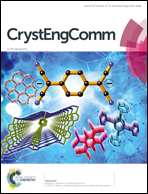Lone pair–π vs. σ-hole–π interactions in bromine head-containing oxacalix[2]arene[2]triazines†
Abstract
Two new bromine head-containing oxacalix[2]arene[2]triazines were designed and synthesized. Owing to the bromine head and complementary V-shaped cavity, the solid state structure of oxacalix[2]arene[2]triazine having N,N-dipropylamino substituents showed an intriguing and unique 1D-supramolecular chain-like self-assembly. To provide deep insight into the true nature of the observed stabilizing interactions, i.e., lone pair–π or σ-hole–π interactions, theoretical calculations were carried out. The computations confirm the presence of genuine σ-hole–π interactions. On the other hand, the calculations on the analogous oxacalix[2]arene[2]triazine having chlorine substituents revealed the greater π-acidic character of the s-triazine rings, thus proposing the cleft-like cavity to be more suitable for lone pair–π interactions. This is supported by retrieving the X-ray single crystal structure of the parent oxacalix[2]arene[2]triazine from the CSD which showed the existence of mixed lone pair–π/σ-hole–π and true lone pair–π interactions in the solid state. The study provides constructive clues on the utility of these macrocycles in host–guest and related fields of supramolecular chemistry.
![Graphical abstract: Lone pair–π vs. σ-hole–π interactions in bromine head-containing oxacalix[2]arene[2]triazines](/en/Image/Get?imageInfo.ImageType=GA&imageInfo.ImageIdentifier.ManuscriptID=C8CE00666K&imageInfo.ImageIdentifier.Year=2018)


 Please wait while we load your content...
Please wait while we load your content...